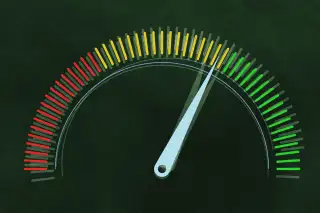The Average Credit Score Just Dropped for the First Time Since 2009

The average credit score has ticked down for the first time in over a decade.
The drop is just one point, from 718 to 717, but it's still a major indicator that Americans are struggling with debt. Data analytics company FICO, the creator of one of the most commonly used credit scores, said in a report released Wednesday that rising debt and delinquencies are to blame.
FICO scores, which are relied on by most U.S. lenders to determine whether to provide loans to customers, usually range from 300 to about 850. A credit score of 670 to 739 is considered "good," and anything above that is "very good" or "excellent," indicating that a borrower is a safe risk.
On the whole, credit scores have been rising steadily since the end of 2009, when the national average was a lukewarm 686 amid the Great Recession. Since then, the average credit score has risen over 30 points, thanks in part to the removal of negative information like medical debt from credit reports (a policy enacted in 2022) and federal financial aid during the pandemic. In April 2023, the average score reached 718, the highest ever recorded, and held at that level through FICO’s last analysis in July.
This most recent data point is from October.
Why credit scores are down
Factors like missed payments, credit card over-utilization and defaulting on debt can cause credit scores to decrease.
In addition to the dip in the average score, FICO data shows that the delinquency rate — which indicates how much of the population has missed a payment by 30 days or more — rose to 18% in October, 4% higher than in April. The average credit utilization, which is the percentage of available credit a customer is using at any given time, rose to 35% (it’s generally recommended to keep credit utilization at no more than 30%).
FICO scores are a lagging economic indicator, meaning they reflect long-term trends but don’t necessarily predict them. While a one-point decline doesn’t mean the country is in an economic crisis, FICO said the decrease suggests that high interest rates and stubborn inflation are starting to weigh on consumers.
Other measures of consumer credit health have shown similar trends. Recent Federal Reserve Bank of New York data shows auto loan delinquencies continued to rise in the last quarter of 2023. VantageScore, another consumer credit scoring system, found that delinquencies across all credit products ticked up to their highest levels in four years in January.
The reason(s) borrowers are struggling
Looking at recent trends in borrowing, it’s not surprising that consumers are having trouble managing their debt. U.S. households are carrying a record $1.13 trillion in total credit card debt. Total household debt now sits at $17.5 trillion.
During the pandemic, many Americans were able to squirrel away money thanks to reduced spending and stimulus payments. But surging inflation over the past few years and the Federal Reserve’s subsequent interest rate hikes largely depleted those savings. As a result, more people have turned to credit cards to cover rising household expenses.
Now that the average credit card annual percentage rate, or APR, is hovering above a record 21%, those bills are becoming more difficult to pay off. And with inflation still higher than the Fed’s 2% long-run target, consumers are continuing to grapple with increased prices and interest rates.
At the same time, certain essentials, like auto and homeowners insurance, are still climbing. Student loan payments also returned in the fall after a more than three-year pause due to the pandemic.
While the Fed is expected to gradually start cutting the federal funds rate sometime this year, there’s no saying when (or how much) interest rates will actually go down. It’s unlikely that rates on products like credit cards will decline significantly by the end of 2024.
Consumers will have to get creative to manage the combination of high prices and elevated interest rates in order to keep their debt from becoming even more unmanageable. For help, be sure to check out Money’s advice for paying off credit card debt.
More from Money:
Biden Aims to Spur Economic Competition — and Lower Prices — With New Task Force
How High Could Home Insurance Rates Jump This Year? Here's What Experts Predict